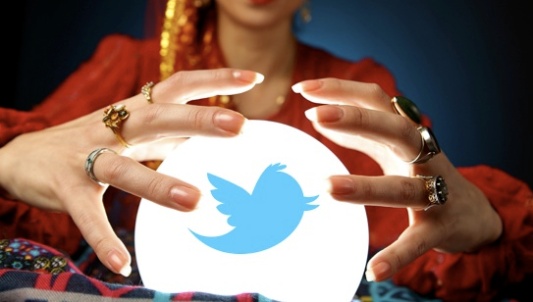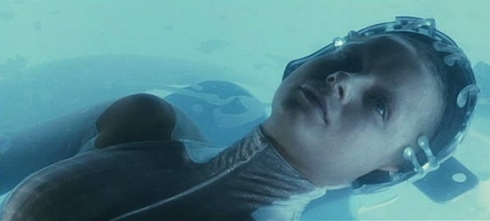Nine weeks ago, as my classmates and I started studying emerging media and the market, we were presented with a clip from 2002’s Minority Report in which hypothetical emerging media targeted the holy heck out of Tom Cruise’s character with marketing messages.
This week, science fact leap-frogged science fiction in yet another echo of Minority Report: precognition.
The film (and in the Philip K. Dick short story on which it’s based) centers on the concept of “precrime.” Law enforcement, through ESP-enhanced “precogs” can determine, with relative certainty, if you’re going to commit a crime and simply arrest you before anyone gets hurt or ripped off.
Today, a group of researchers at U.C. Santa Barbara presented research that suggests you don’t need to be a mutant soaking in rubber cement to predict a person’s future behavior. All you have to do is follow their hashtags. According to the MIT Technology Review:
Today, Petko Bogdanov at the University of California Santa Barbara and a few pals take a new, genetically inspired approach to this task. They say every person has a fixed set of interests, called their social-media genotype, which determines their pattern of behaviour on networks such as Twitter. What’s more, they say that once these genotypes have been discovered, they can be used to predict an individual’s future behaviour.that users tend to adopt a stable pattern of hashtag adoption by these topics. This is their social-media genotype.
“That’s a powerful trick to pull off. The ability to predict the behaviour of individuals on Twitter is worth its weight in gold,” Technology Review said.
You can download the entire study as a .pdf file here.
First and foremost, some basic genetic terminology so we can try to better understand the metaphor. The City University of New York-Brooklyn defines a genotype as:
the “internally coded, inheritable information” carried by all living organisms. This stored information is used as a “blueprint” or set of instructions for building and maintaining a living creature.
Some examples of genotype:
- The gene responsible for eye color
- The gene responsible for hair color
- The gene responsible for height
- The gene responsible for how your voice sounds
- The gene responsible for certain diseases
- The gene responsible for certain behaviors
- The gene responsible for the size of a bird’s beak
- The gene responsible for the length of a fox’s tail
- The gene responsible for the color of stripes on a cat
- The gene responsible for the spots on a dog’s back
- The gene responsible for a person’s shoe size
While this metaphor may be a little stretched (and, I don’t know about you, but it makes me a little squirmy) my interpretation of their findings is that they may be on the threshold of finding something a little more enigmatic, more subtle and yes, more predictive than what we already know about the dynamic between content creators and their followers.
Here’s the key question taken directly from the study:
Which followees are likely to influence a given user to adopt a hashtag of a certain topic and analogously which followers are likely to adopt a hashtag? This question is of paramount importance from both research and practical perspectives. On one hand, uncovering the provider-seeker influence will further our understanding of the global network information dynamics. On the other hand, the question has practical implications for social media users offering guidelines on following high-utility sources or keeping the follower audience engaged.
I have a vague grasp of the research methods employed in this study, but I won’t pretend to fully understand them. As a student of emerging media and the market, the crux of the study is in those last five words “keeping the follower audience engaged.” I could pontificate on the marketing value of this phrase for paragraphs, but for me and my classmates, it’s not necessary: we are always trying to boost engagement through greater audience understanding.
The marketing implications are Tom Cruise blockbuster-sized. So are the corresponding ethical questions. But beyond asking “is it right?” we should also be asking “will it work?”
Part of the reason audience research has to move so quickly is because audiences aren’t predictable. They may behave in ways from which we can infer patterns that may have a predictive function that helps us craft a message they’ll be less likely to ignore. That’s my abbreviated understanding of audience insight. When we venture into the realm of “audience foresight,” confidence levels will drop.
Again, from the Tech Review:
…as other groups have found, it’s one thing to demonstrate this predictability on a test data set. It’s quite another to do it with a live feed from Twitter. The acid test will be whether Bogdanov and co can predict a real individual’s behaviour tomorrow with the data they gather today. If they can, the road to the future will be paved with gold. We look forward to seeing the evidence in the not too distant future.
Philip K. Dick’s vision of the future in The Minority Report questioned the existence of free will and also questioned whether we’d really want to know if there’s no such thing.
Marketers (and ethicists) need to be paying attention to this study and results of the aforementioned “acid test.”
If our audiences don’t have free will on social media, will they resent our exploitation of it? And, more importantly, will they resent us for figuring that out?
What do you think? Is this just a natural extension of audience research or are we wandering into some creepy-freaky ethical territory?
Your comments are welcome and pre-approved. I already know what you’re going to say anyway.

